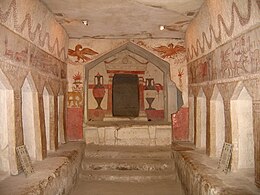| UNESCO World Heritage Site | |
|---|---|
 | |
| Location | Shfela, Israel, |
| Part of | Caves of Maresha and Bet-Guvrin in the Judean Lowlands as a Microcosm of the Land of the Caves |
| Criteria | Cultural: (v) |
| Reference | 1370 |
| Inscription | 2014 (38th Session) |
| Coordinates | 31°35′35″N 34°53′54″E / 31.59306°N 34.89833°E |
Maresha was an Iron Age city mentioned in the Hebrew Bible, whose remains have been excavated at Tell Sandahanna (Arabic name), an archaeological mound or 'tell' renamed after its identification to Tel Maresha (Hebrew: תל מראשה). The ancient Judahite city became Idumaean after the fall of Judah in 586 BCE, and after Alexander's conquest of the region in 332 BCE became Hellenised under the name Marisa or Marissa.[1][2] The tell is situated in Israel's Shephelah region, i.e. in the foothills of the Judaean Mountains, about 1.5 kilometres (0.93 mi) south of Beit Gubrin.[2]
Excavations revealed that Maresha was inhabited (not necessarily continuously) during the Iron Age, the Persian period, and the Hellenistic period.[3] The Hasmonean ruler John Hyrcanus seized Maresha in 113/112 BCE, leading to its decline and eventual desertion. The city faced its ultimate destruction at the hands of the Parthians in 40 BCE.[4]
Maresha was first excavated in 1898–1900 by the British archaeologists Bliss and Macalister on behalf of the Palestine Exploration Fund (PEF) and again after 1989 by Israeli archaeologist Amos Kloner on behalf of the Israel Antiquities Authority (IAA).[1] Most of the artifacts of the British excavation are to be found today in the Istanbul Archaeology Museums.[citation needed]
This site is now protected as part of Beit Guvrin-Maresha National Park and its burial caves are recognized by UNESCO as a World Heritage Site.[5]
- ^ a b Avraham Negev and Shimon Gibson (2001). "Mareshah (Tell); Marissa; Sandahannah (Tell)". Archaeological Encyclopedia of the Holy Land. New York and London: Continuum. p. 315. ISBN 0826413161.
- ^ a b Kloner, Amos; et al. (2003). "Introduction". Maresha Excavations Final Report I: Subterranean Complexes 21, 44, 70. IAA Reports. Vol. 17. IAA. doi:10.2307/j.ctt1fzhfp4. JSTOR j.ctt1fzhfp4. Retrieved 31 August 2024.
Maresha (Marisa, Marissa) ... Maresha (Marissa is the Greek form of the Hebrew name)
- ^ Kloner, Amos; Stern, Ian (2007). "Idumea in the Late Persian Period (Fourth Century B.C.E.)". In Lipschits, Oded; Knoppers, Gary N.; Albertz, Rainer (eds.). Judah and the Judeans in the Fourth Century B.C.E. Penn State University Press. pp. 139–143. ISBN 9781575065809.
- ^ Regev, Dalit (2023). "Sidonians at Marisa (Maresha)". 'Atiqot / עתיקות. 110: 65–82. ISSN 0792-8424. JSTOR 27204900.
- ^ "Caves of Maresha and Bet-Guvrin in the Judean Lowlands as a Microcosm of the Land of the Caves". UNESCO.
